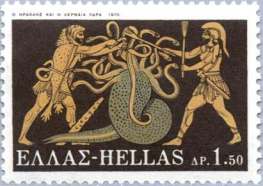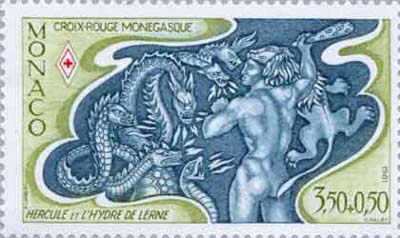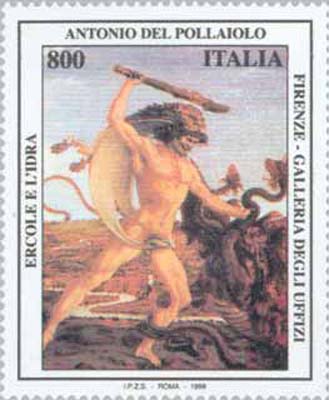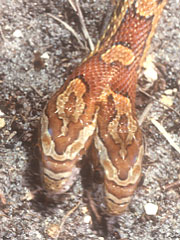.



Italy 1998, the artist has choosen a very spectacular way of how Hercules “wears” the Nemean Lion (the way it is fixed)

Hercules with Chronos (?) and the Hydra
Hercules and the Hydra. Is it possible that Hercules was fighting with this small Hydra? The Hydra was a child of Typhon and Echidna ie a half-sister of the Nemean Lion. It lived near a spring Amymone and had many heads which grow back when cut off. Iolaos, the son of Iphicles, helps his half-brother Hercules by cauterizing the wounds where the necks of the Hydra were cut through before a new head could grow back. Hercules usds the body of the Hydra to produce his poisoned arrows. Probably there is some relation between the word "toxic" and the Greek word "toxon," meaning arrow. An explanation is that the myth commemorates a plague which devastated the population of ancient Lernea.

A true but microscopic Hydra

Some living creatures like two-headed snakes, such as the example of Thelma and Louise at the San Diego Zoo, that are not very rare may have contributed to the mythological stories.
Christina A. Salowey about the Lernea Hydra in “ Herakles and Healing Cult in the Peloponnesos”:
The Lernean Hydra Labor is a case in point. It is not difficult to discover the refracted image of the multiple sources of a marshy area in the polykephalic form of the Hydra; a multitude of writhing snakes is enough to suggest a swamp, but the nature of her destruction is specified as agricultural and her blood is poisonous (Eur. Her. 422, 1188; Soph. Trach. 572 - 577), both qualities are apt metaphors for the stagnant and invasive waters of a swamp. Herakles cannot kill the monster with ordinary weapons but must resort to the use of firebrands, fire being the antithesis of water, and Apollodoros (Bibl. 2.5.2) preserves a version of the myth that Herakles could not kill one immortal head of the Hydra but had to bury it underground, a description which sounds like retraining of a watercourse. Later scholiasts , Lactantius and Servius, are explicit about the interpretation of the myth, that the Lernean Hydra was a swamp (Si veram quaeramus historiam, Lerna palus fuit), the waters of which Hercules dried up. The Lernean Hydra is characterized as the bane of Argos (Eur. Phoen. 1137) and it is likely that the marshy geology of the entire Argive plain contributed to the creation of a legendary swamp creature.
Was it mathematically possible to kill the Hydra ? The answer is yes!: HERCULES AND THE HYDRA: A PROBLEM IN COMBINATORICS (PDF) and Hercule et l'hydre (French)
See also : Greek Mythology. Paintings, Drawings
| Ancient Greece
Science, Technology , Medicine , Warfare, , Biographies , Life , Cities/Places/Maps , Arts , Literature , Philosophy ,Olympics, Mythology , History , Images Medieval Greece / Byzantine Empire Science, Technology, Arts, , Warfare , Literature, Biographies, Icons, History Modern Greece Cities, Islands, Regions, Fauna/Flora ,Biographies , History , Warfare, Science/Technology, Literature, Music , Arts , Film/Actors , Sport , Fashion --- |

